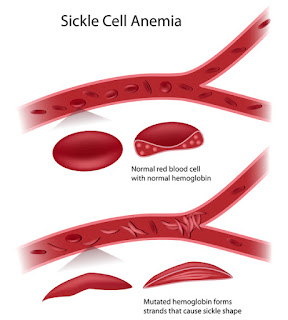 A mutation is an unpredictable change in the genetic material of an organism.
A mutation is an unpredictable change in the genetic material of an organism.Gene mutation: change in the structure of a DNA molecule, producing a different allele of a gene.
Chromosome mutation: changes in the structure or number of whole chromosomes in a cell.
Sources/ mutagens : increase chances of a mutation occuring
- random
- environmental factors (ionising radiations alpha, beta, gamma; UV radiation; chemicals)
Gene mutations
Types:
- base substitution
- base addition
- base deletion
Consequences:
- silent: same amino acid; a mutation that has no apparent effect on the organism
- missense: different amino acid; no apparent effect
- nonsense: introduce a 'stop' triplet
- frame shift: protein that is made becomes totally useless
Base substitution in the gene that codes for the amino acid sequence in the β-globin
Glutamic acid --> valine; HbA allele --> HbS allele
Effects: Haemoglobin molecule becomes much less soluble
- molecules stick together and form long fibres inside red blood cells
- rbc are pulled out of shape, into a half-moon or sickle shape
- distorted cells become stuck in small capillaries and so cannot transport oxygen, block normal rbcs getting through
2. Albinism
- Classic form - Autosomal recessive mutation: individuals that are homozygous for the recessive allele show albinism
- Other forms - mutation at several loci; sex-linked
- absence of tyrosinase
- presence of inactive tyrosinase
Effects:
- dark pigment melanin partially/totally missing from eyes, skin or hair
- poor vision; rapid, jerky eye movement; avoids bright light
3. Huntington's disease:
Mutation inherited as a dominant allele. The mutation is an unstable segment in a gene on chromosome 4 coding for a protein called huntingtin.
- Non-sufferers: small number of repeats of the triplet of bases CAG
- Sufferer: 'stutter' - larger number of CAG repeats CAG CAG CAG CAG CAG CAG CAG
Effects:
- HD is a neurological disorder resulting in involuntary movements (chorea) and progressive mental deterioration.
- The age of onset is variable, but occurs most commonly in middle age.
- The more CAG stutters, the earlier the age of onset.
4. Haemophilia
- Gene codes for the production of protein for blood-clotting 'factor VIII'
- H: dominant allele
- h: recessive allele - blood fails to clot properly
16.2 The roles of genes in determining the phenotype Studies of human genetic conditions have revealed the links between genes, enzymes and the phenotype. a) explain the terms gene, locus, allele, dominant, recessive, codominant, linkage, test cross, F1 and F2, phenotype, genotype, homozygous and heterozygous b) use genetic diagrams to solve problems involving monohybrid and dihybrid crosses, including those involving autosomal linkage, sex linkage, codominance, multiple alleles and gene interactions (the term epistasis does not need to be used; knowledge of the expected ratio for various types of epistasis is not required. The focus is on problem solving) c) use genetic diagrams to solve problems involving test crosses d) use the chi-squared test to test the significance of differences between observed and expected results (the formula for the chi-squared test will be provided) (see Mathematical requirements) e) explain that gene mutation occurs by substitution, deletion and insertion of base pairs in DNA and outline how such mutations may affect the phenotype f) outline the effects of mutant alleles on the phenotype in the following human conditions: albinism, sickle cell anaemia, haemophilia and Huntington’s disease g) explain the relationship between genes, enzymes and phenotype with respect to the gene for tyrosinase that is involved with the production of melanin |

















